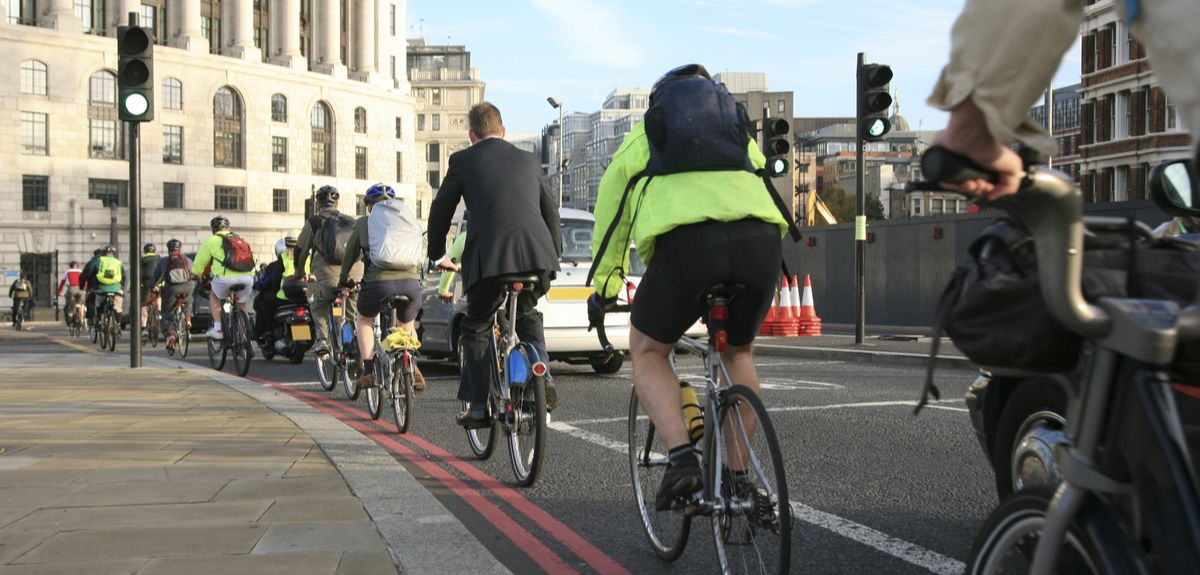
Get on your bike: Active transport makes a significant impact on carbon emissions
Cycling, e-biking or walking can help tackle the climate crisis – even if you swap the car for active transport just one day a week - according to a new study led by researchers from the University of Oxford’s Transport Studies Unit.
Emission targets are unlikely to be met without a significant move away from motorised transport, according to the researchers, and shifting to active transport could save as much as a quarter of personal CO2 emissions from transport.
Emission targets are unlikely to be met without a significant move away from motorised transport, according to the researchers, and shifting to active transport could save as much as a quarter of personal CO2 emissions from transport
Published in the journal Global Environmental Change, this is the first study of the carbon-reducing impact of city-based lifestyle changes and it reveals that increases in active mobility significantly lower carbon footprints, even in urban European contexts with a high incidence of walking and cycling.
‘By following nearly 2,000 urban dwellers over time, we found that those who switch just one trip per day from car driving to cycling reduce their carbon footprint by about 0.5 tonnes over a year, representing a substantial share of average per capita CO2 emissions,’ says the lead researcher, Oxford’s Dr Christian Brand. ‘If just 10% of the population were to change travel behaviour, the emissions savings would be around 4% of lifecycle CO2 emissions from all car travel.’
We found that those who switch just one trip per day from car driving to cycling reduce their carbon footprint by about 0.5 tonnes over a year, representing a substantial share of average per capita CO2 emissions
Dr Christian Brand
Dr Brand says, ‘Our findings suggest that, even if not all car trips could be substituted by bicycle trips, the potential for decreasing emissions is huge.’
Researchers found active travel substitutes for motorised travel – and increases in cycling, e-biking or walking over time independently lowers mobility-related lifecycle CO2 emissions. And swapping the car for a bike or e-bike for just one day a week – or going from ‘not cycling’ to ‘cycling’ – drastically lowers mobility-related lifecycle CO2.
The analysis comes as UK, and the world, enters the 2020s - what needs to be a ‘decade of action’, if global goals to limit rising temperatures are to be met. Ahead of this November’s COP26 UN climate summit in Glasgow, countries are expected to submit enhanced pledges to tackle emissions.
To put this into context, for the cities in this study, average per capita CO2 emissions from transport (excl. international aviation and shipping) ranged between 1.8 tonnes of CO2 per person per year in the UK to 2.7 tonnes of CO2 per person per year in Austria. According to the Global Carbon Atlas, average per capita CO2 emissions from all activities were eight tonnes per year in the UK (on a consumption basis).
Swapping the car for a bike or e-bike for just one day a week – or going from ‘not cycling’ to ‘cycling’ – drastically lowers mobility-related lifecycle CO2
The largest benefits from shifts from car to active travel are for business travel, followed by social and leisure trips, and commuting to work or place of study. The finding that those who already cycled had 84% lower CO2 emissions from all daily travel than non-cyclists further shows the population benefits of travelling actively that already exist.
The study collected primary data on daily travel behaviour, journey purpose, as well as personal and geospatial characteristics in seven European cities and derived mobility-related lifecycle CO2 emissions over time and space.
Statistical modelling of longitudinal panel data of 1,849 study participants was performed to assess how changes in active mobility, the ‘main mode’ of daily travel, and cycling frequency influenced changes in mobility-related lifecycle CO2 emissions.
A typical response to the climate crisis is to ‘do something’, such as planting more trees, or switching to electric vehicles....Switching from car to active mobility is one thing to do, which would make a real difference
Dr Brand
Dr Brand says, ‘A typical response to the climate crisis is to ‘do something’, such as planting more trees, or switching to electric vehicles. While these are important and effective, they are neither sufficient nor fast enough to meet our ambitious climate targets.
‘Doing more of a good thing combined with doing less of a bad thing – and doing it now is much more compliant with a ‘net zero’ pathway and preserving our ‘perfect planet’s’ and our own futures.
‘Switching from car to active mobility is one thing to do, which would make a real difference, and we show here how good this can be in cities. Not just for the climate but also for reducing social inequalities and improving public health and quality of urban life in a post-COVID-19 world.’
Cities across the world will need to increase investment in high-quality infrastructure for pedestrians and cyclists and incorporate policy and planning concepts that require a fairly radical rethink of our cities and is likely to reduce inequalities because the concepts involve mixing different population groups rather than maintaining the model of residential zoning by socioeconomic status currently used.
Reference:
Brand, C., Götschi, T., Dons, E., Gerike, R., Anaya-Boig, E., Avila-Palencia, I., de Nazelle, A., Gascon, M., Gaupp-Berghausen, M., Iacorossi, F., Kahlmeier, S., Int Panis, L., Racioppi, F., Rojas-Rueda, D., Standaert, A., Stigell, E., Sulikova, S., Wegener, S., Nieuwenhuijsen, M.J. (2021) The climate change mitigation impacts of active travel: Evidence from a longitudinal panel study in seven European cities. Global Environmental Change 67, 102224. https://doi.org/10.1016/j.gloenvcha.2021.102224
Free access to download and view here: https://authors.elsevier.com/a/1cV3b3Q8oQ9QDU
About PASTA:
The EU-funded project PASTA - Physical Activity Through Sustainable Transport Approaches - aims to connect transport and health by promoting active mobility in cities (i.e. walking, cycling or e-biking, including in combination with public transport use) as an innovative way of integrating physical activity into our daily lives. As part of the PASTA project, researchers have listed a number of good practices for cities to promote active mobility.
- The study reported here is the first study of lifecycle carbon emissions effects of changes in active travel in cities - active travel (walking or cycling for transport) is considered the most sustainable and low carbon form of getting from A to B, yet the net effects of changes in active travel on changes in mobility-related CO2 emissions are complex and under-researched.
- The methodology, metrics and findings are applicable to many cities across Europe and provide much needed empirical evidence for exploring transport and climate futures at the global, national, and local levels.
 Largest ever UK study reveals stark ethnic and social inequalities in lung cancer diagnosis
Largest ever UK study reveals stark ethnic and social inequalities in lung cancer diagnosis
 Oxford’s gargoyles come to life in new Extended Reality (XR) interactive experience
Oxford’s gargoyles come to life in new Extended Reality (XR) interactive experience
 Treating bullying as everyone’s problem reduces incidence in primary schools
Treating bullying as everyone’s problem reduces incidence in primary schools
 Oxford's Ashmolean Museum saves Fra Angelico masterpiece to go on public display from December
Oxford's Ashmolean Museum saves Fra Angelico masterpiece to go on public display from December
 New, ARIA-backed project aims to unlock radically cheaper AI hardware
New, ARIA-backed project aims to unlock radically cheaper AI hardware